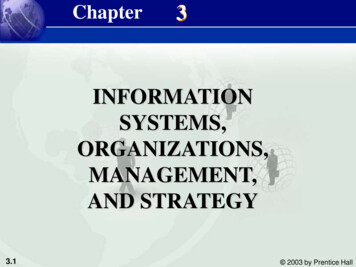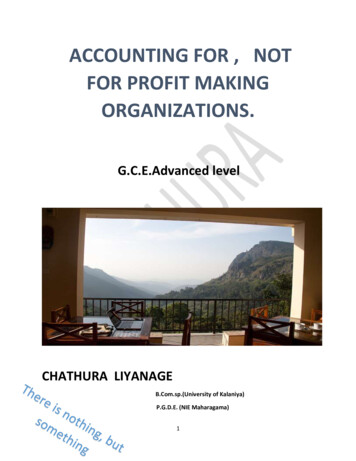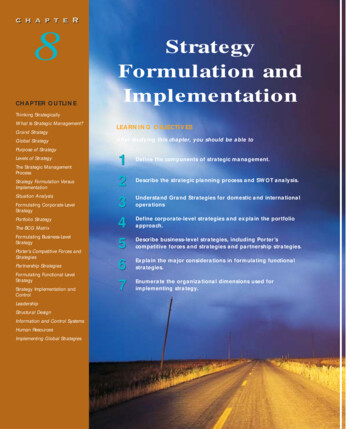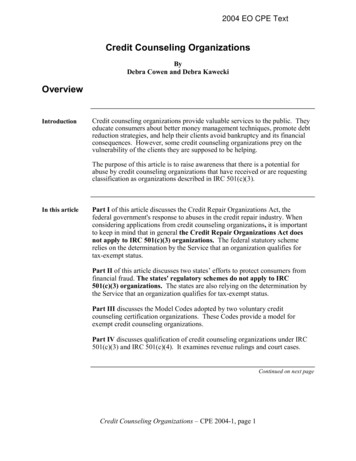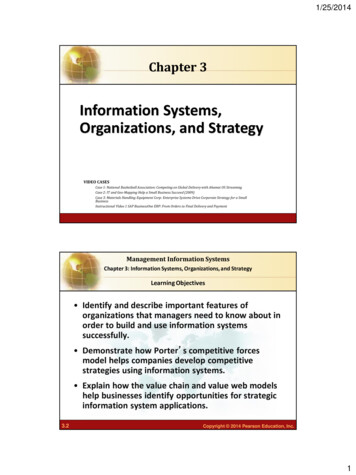
Transcription
1/25/2014Chapter 3Information Systems,Organizations, and StrategyVIDEO CASESCase 1: National Basketball Association: Competing on Global Delivery with Akamai OS StreamingCase 2: IT and Geo-Mapping Help a Small Business Succeed (2009)Case 3: Materials Handling Equipment Corp: Enterprise Systems Drive Corporate Strategy for a SmallBusinessInstructional Video 1 SAP BusinessOne ERP: From Orders to Final Delivery and PaymentManagement Information SystemsChapter 3: Information Systems, Organizations, and StrategyLearning Objectives Identify and describe important features oforganizations that managers need to know about inorder to build and use information systemssuccessfully. Demonstrate how Porter’s competitive forcesmodel helps companies develop competitivestrategies using information systems. Explain how the value chain and value web modelshelp businesses identify opportunities for strategicinformation system applications.3.2Copyright 2014 Pearson Education, Inc.1
1/25/2014Management Information SystemsChapter 3: Information Systems, Organizations, and StrategyLearning Objectives (cont.) Demonstrate how information systems helpbusinesses use synergies, core competencies,and network-based strategies to achievecompetitive advantage. Assess the challenges posed by strategicinformation systems and managementsolutions.3.3Copyright 2014 Pearson Education, Inc.Management Information SystemsChapter 3: Information Systems, Organizations, and StrategyWill Sears’s Technology Strategy Work This Time? Problem: Fading brand, powerfulcompetitors, technology costs Solutions:– Customer data mining to improve customerintimacy, design sales floors, implementcustomer programs and promotions Demonstrates IT’s central role in definingcompetitive strategy3.4Copyright 2014 Pearson Education, Inc.2
1/25/2014Management Information SystemsChapter 3: Information Systems, Organizations, and StrategyOrganizations and Information Systems Information technology and organizationsinfluence each other– Relationship influenced by organization’s Structure Business processes Politics Culture Environment Management decisions3.5Copyright 2014 Pearson Education, Inc.Management Information SystemsChapter 3: Information Systems, Organizations, and StrategyTHE TWO-WAY RELATIONSHIP BETWEEN ORGANIZATIONS AND INFORMATION TECHNOLOGYThis complex two-wayrelationship is mediated bymany factors, not the least ofwhich are the decisionsmade—or not made—bymanagers. Other factorsmediating the relationshipinclude the organizationalculture, structure, politics,business processes, andenvironment.FIGURE 3-13.6Copyright 2014 Pearson Education, Inc.3
1/25/2014Management Information SystemsChapter 3: Information Systems, Organizations, and StrategyOrganizations and Information Systems What is an organization?– Technical definition: Formal social structure that processes resources fromenvironment to produce outputs A formal legal entity with internal rules andprocedures, as well as a social structure– Behavioral definition: A collection of rights, privileges, obligations, andresponsibilities that is delicately balanced over a periodof time through conflict and conflict resolution3.7Copyright 2014 Pearson Education, Inc.Management Information SystemsChapter 3: Information Systems, Organizations, and StrategyTHE TECHNICAL MICROECONOMIC DEFINITION OF THE ORGANIZATIONFIGURE 3-23.8In the microeconomic definition of organizations, capital and labor (the primary production factors provided bythe environment) are transformed by the firm through the production process into products and services(outputs to the environment). The products and services are consumed by the environment, which suppliesadditional capital and labor as inputs in the feedback loop.Copyright 2014 Pearson Education, Inc.4
1/25/2014Management Information SystemsChapter 3: Information Systems, Organizations, and StrategyTHE BEHAVIORAL VIEW OF ORGANIZATIONSThe behavioral viewof organizationsemphasizes grouprelationships, values,and structures.FIGURE 3-33.9Copyright 2014 Pearson Education, Inc.Management Information SystemsChapter 3: Information Systems, Organizations, and StrategyOrganizations and Information Systems Features of organizations Use of hierarchical structure Accountability, authority in system of impartialdecision making Adherence to principle of efficiency Routines and business processes Organizational politics, culture, environments,and structures3.10Copyright 2014 Pearson Education, Inc.5
1/25/2014Management Information SystemsChapter 3: Information Systems, Organizations, and StrategyOrganizations and Information Systems Routines and business processes Routines (standard operating procedures) Precise rules, procedures, and practicesdeveloped to cope with virtually allexpected situations Business processes: Collections of routines Business firm: Collection of businessprocesses3.11Copyright 2014 Pearson Education, Inc.Management Information SystemsChapter 3: Information Systems, Organizations, and StrategyROUTINES, BUSINESS PROCESSES, AND FIRMSAll organizations are composedof individual routines andbehaviors, a collection ofwhich make up a businessprocess. A collection ofbusiness processes make up thebusiness firm. New informationsystem applications require thatindividual routines andbusiness processes change toachieve high levels oforganizational performance.FIGURE 3-43.12Copyright 2014 Pearson Education, Inc.6
1/25/2014Management Information SystemsChapter 3: Information Systems, Organizations, and StrategyOrganizations and Information Systems Organizational politics Divergent viewpoints lead to politicalstruggle, competition, and conflict. Political resistance greatly hampersorganizational change.3.13Copyright 2014 Pearson Education, Inc.Management Information SystemsChapter 3: Information Systems, Organizations, and StrategyOrganizations and Information Systems Organizational culture: Encompasses set of assumptions thatdefine goal and product What products the organization should produce How and where it should be produced For whom the products should be produced May be powerful unifying force as well asrestraint on change3.14Copyright 2014 Pearson Education, Inc.7
1/25/2014Management Information SystemsChapter 3: Information Systems, Organizations, and StrategyOrganizations and Information Systems Organizational environments: Organizations and environments have a reciprocalrelationship. Organizations are open to, and dependent on, thesocial and physical environment. Organizations can influence their environments. Environments generally change faster thanorganizations. Information systems can be instrument ofenvironmental scanning, act as a lens.3.15Copyright 2014 Pearson Education, Inc.Management Information SystemsChapter 3: Information Systems, Organizations, and StrategyENVIRONMENTS AND ORGANIZATIONS HAVE A RECIPROCAL RELATIONSHIPFIGURE 3-53.16Environments shape what organizations can do, but organizations can influence their environments and decideto change environments altogether. Information technology plays a critical role in helping organizationsperceive environmental change and in helping organizations act on their environment.Copyright 2014 Pearson Education, Inc.8
1/25/2014Management Information SystemsChapter 3: Information Systems, Organizations, and StrategyOrganizations and Information Systems Disruptive technologies– Technology that brings about sweeping changeto businesses, industries, markets– Examples: personal computers, word processingsoftware, the Internet, the PageRank algorithm– First movers and fast followers First movers—inventors of disruptivetechnologies Fast followers—firms with the size andresources to capitalize on that technology3.17Copyright 2014 Pearson Education, Inc.Management Information SystemsChapter 3: Information Systems, Organizations, and StrategyOrganizations and Information Systems 5 basic kinds of organizational structure– Entrepreneurial: Small start-up business– Machine bureaucracy: Midsize manufacturing firm– Divisionalized bureaucracy: Fortune 500 firms– Professional bureaucracy: Law firms, school systems, hospitals– Adhocracy: Consulting firms3.18Copyright 2014 Pearson Education, Inc.9
1/25/2014Management Information SystemsChapter 3: Information Systems, Organizations, and StrategyOrganizations and Information Systems Other organizational features–Goals Coercive, utilitarian, normative, and soon–Constituencies–Leadership styles–Tasks–Surrounding environments3.19Copyright 2014 Pearson Education, Inc.Management Information SystemsChapter 3: Information Systems, Organizations, and StrategyHow Information Systems Impact Organizations and Business Firms Economic impacts– IT changes relative costs of capital and the costs ofinformation– Information systems technology is a factor ofproduction, like capital and labor– IT affects the cost and quality of information andchanges economics of information Information technology helps firms contract in sizebecause it can reduce transaction costs (the cost ofparticipating in markets)– Outsourcing3.20Copyright 2014 Pearson Education, Inc.10
1/25/2014Management Information SystemsChapter 3: Information Systems, Organizations, and StrategyHow Information Systems Impact Organizations and Business Firms Transaction cost theory– Firms seek to economize on transaction costs(the costs of participating in markets). Vertical integration, hiring more employees,buying suppliers and distributors– IT lowers market transaction costs for firm,making it worthwhile for firms to transact withother firms rather than grow the number ofemployees.3.21Copyright 2014 Pearson Education, Inc.Management Information SystemsChapter 3: Information Systems, Organizations, and StrategyHow Information Systems Impact Organizations and Business Firms Agency theory:– Firm is nexus of contracts among self-interestedparties requiring supervision.– Firms experience agency costs (the cost ofmanaging and supervising) which rise as firmgrows.– IT can reduce agency costs, making it possible forfirms to grow without adding to the costs ofsupervising, and without adding employees.3.22Copyright 2014 Pearson Education, Inc.11
1/25/2014Management Information SystemsChapter 3: Information Systems, Organizations, and StrategyHow Information Systems Impact Organizations and Business Firms Organizational and behavioral impacts– IT flattens organizations Decision making is pushed to lower levels. Fewer managers are needed (IT enables fasterdecision making and increases span of control).– Postindustrial organizations Organizations flatten because in postindustrialsocieties, authority increasingly relies onknowledge and competence rather than formalpositions.3.23Copyright 2014 Pearson Education, Inc.Management Information SystemsChapter 3: Information Systems, Organizations, and StrategyFLATTENING ORGANIZATIONSInformation systems can reducethe number of levels in anorganization by providingmanagers with information tosupervise larger numbers ofworkers and by giving lowerlevel employees more decisionmaking authority.FIGURE 3-63.24Copyright 2014 Pearson Education, Inc.12
1/25/2014Management Information SystemsChapter 3: Information Systems, Organizations, and StrategyHow Information Systems Impact Organizations and Business Firms Organizational resistance to change– Information systems become bound up inorganizational politics because they influenceaccess to a key resource—information.– Information systems potentially change anorganization’s structure, culture, politics, andwork.– Most common reason for failure of large projectsis due to organizational and political resistanceto change.3.25Copyright 2014 Pearson Education, Inc.Management Information SystemsChapter 3: Information Systems, Organizations, and StrategyORGANIZATIONAL RESISTANCE AND THE MUTUALLY ADJUSTINGRELATIONSHIP BETWEEN TECHNOLOGY AND THE ORGANIZATIONImplementing informationsystems has consequences fortask arrangements, structures,and people. According to thismodel, to implement change,all four components must bechanged simultaneously.FIGURE 3-73.26Copyright 2014 Pearson Education, Inc.13
1/25/2014Management Information SystemsChapter 3: Information Systems, Organizations, and StrategyHow Information Systems Impact Organizations and Business Firms The Internet and organizations– The Internet increases the accessibility, storage,and distribution of information and knowledgefor organizations.– The Internet can greatly lower transaction andagency costs. Example: Large firm delivers internal manualsto employees via a corporate Web site, savingmillions of dollars in distribution costs3.27Copyright 2014 Pearson Education, Inc.Management Information SystemsChapter 3: Information Systems, Organizations, and StrategyHow Information Systems Impact Organizations and Business Firms Organizational factors in planning a newsystem:– Environment– Structure Hierarchy, specialization, routines, business processes– Culture and politics– Type of organization and style of leadership– Main interest groups affected by system; attitudes ofend users– Tasks, decisions, and business processes the systemwill assist3.28Copyright 2014 Pearson Education, Inc.14
1/25/2014Management Information SystemsChapter 3: Information Systems, Organizations, and StrategyUsing Information Systems to Achieve Competitive Advantage Why do some firms become leaders in theirindustry? Michael Porter’s competitive forces model– Provides general view of firm, its competitors, andenvironment– Five competitive forces shape fate of firm:1.2.3.4.5.3.29Traditional competitorsNew market entrantsSubstitute products and servicesCustomersSuppliersCopyright 2014 Pearson Education, Inc.Management Information SystemsChapter 3: Information Systems, Organizations, and StrategyPORTER’S COMPETITIVE FORCES MODELFIGURE 3-83.30In Porter’s competitive forces model, the strategic position of the firm and its strategies are determined notonly by competition with its traditional direct competitors but also by four other forces in the industry’senvironment: new market entrants, substitute products, customers, and suppliers.Copyright 2014 Pearson Education, Inc.15
1/25/2014Management Information SystemsChapter 3: Information Systems, Organizations, and StrategyUsing Information Systems to Achieve Competitive Advantage Traditional competitors– All firms share market space with competitors whoare continuously devising new products, services,efficiencies, and switching costs. New market entrants– Some industries have high barriers to entry, forexample, computer chip business.– New companies have new equipment, youngerworkers, but little brand recognition.3.31Copyright 2014 Pearson Education, Inc.Management Information SystemsChapter 3: Information Systems, Organizations, and StrategyUsing Information Systems to Achieve Competitive Advantage Substitute products and services– Substitutes customers might use if your pricesbecome too high, for example, iTunes substitutes forCDs Customers– Can customers easily switch to competitor’sproducts? Can they force businesses to compete onprice alone in transparent marketplace? Suppliers– Market power of suppliers when firm cannot raiseprices as fast as suppliers3.32Copyright 2014 Pearson Education, Inc.16
1/25/2014Management Information SystemsChapter 3: Information Systems, Organizations, and StrategyUsing Information Systems to Achieve Competitive Advantage Four generic strategies for dealingwith competitive forces, enabled byusing IT:– Low-cost leadership– Product differentiation– Focus on market niche– Strengthen customer and supplierintimacy3.33Copyright 2014 Pearson Education, Inc.Management Information SystemsChapter 3: Information Systems, Organizations, and StrategyUsing Information Systems to Achieve Competitive Advantage Low-cost leadership– Produce products and services at a lower price thancompetitors– Example: Walmart’s efficient customer responsesystem Product differentiation– Enable new products or services, greatly changecustomer convenience and experience– Example: Google, Nike, Apple– Mass customization3.34Copyright 2014 Pearson Education, Inc.17
1/25/2014Management Information SystemsChapter 3: Information Systems, Organizations, and StrategyUsing Information Systems to Achieve Competitive Advantage Focus on market niche– Use information systems to enable a focusedstrategy on a single market niche; specialize– Example: Hilton Hotels’ OnQ system Strengthen customer and supplier intimacy– Use information systems to develop strong ties andloyalty with customers and suppliers– Increase switching costs– Example: Netflix, Amazon3.35Copyright 2014 Pearson Education, Inc.Management Information SystemsChapter 3: Information Systems, Organizations, and StrategyInteractive Session: OrganizationsTechnology Helps Starbucks Find New Ways to CompeteRead the Interactive Session and discuss the following questions– Analyze Starbucks using the competitive forcesand value chain models.– What is Starbucks’ business strategy? Assess therole played by technology in this businessstrategy.– How much has technology helped Starbuckscompete? Explain your answer.3.36Copyright 2014 Pearson Education, Inc.18
1/25/2014Management Information SystemsChapter 3: Information Systems, Organizations, and StrategyUsing Information Systems to Achieve Competitive Advantage The Internet’s impact on competitiveadvantage– Transformation or threat to some industries Examples: travel agency, printed encyclopedia, media– Competitive forces still at work, but rivalry moreintense– Universal standards allow new rivals, entrants tomarket– New opportunities for building brands and loyalcustomer bases3.37Copyright 2014 Pearson Education, Inc.Management Information SystemsChapter 3: Information Systems, Organizations, and StrategyUsing Information Systems to Achieve Competitive Advantage Value chain model– Firm as series of activities that add value to productsor services– Highlights activities where competitive strategiescan best be applied Primary activities vs. support activities– At each stage, determine how information systemscan improve operational efficiency and improvecustomer and supplier intimacy– Utilize benchmarking, industry best practices3.38Copyright 2014 Pearson Education, Inc.19
1/25/2014Management Information SystemsChapter 3: Information Systems, Organizations, and StrategyTHE VALUE CHAIN MODELThis figure provides examplesof systems for both primaryand support activities of a firmand of its value partners thatcan add a margin of value to afirm’s products or services.FIGURE 3-93.39Copyright 2014 Pearson Education, Inc.Management Information SystemsChapter 3: Information Systems, Organizations, and StrategyInteractive Session: TechnologyAutomakers Become Software CompaniesRead the Interactive Session and discuss the following questions How is software adding value to automakers’products? How are the automakers benefiting from softwareenhanced cars? How are customers benefiting? What value chain activities are involved in enhancingcars with software? How much of a competitive advantage is softwareproviding for automakers? Explain your answer.3.40Copyright 2014 Pearson Education, Inc.20
1/25/2014Management Information SystemsChapter 3: Information Systems, Organizations, and StrategyUsing Information Systems to Achieve Competitive Advantage Value web:– Collection of independent firms usinghighly synchronized IT to coordinate valuechains to produce product or servicecollectively– More customer driven, less linearoperation than traditional value chain3.41Copyright 2014 Pearson Education, Inc.Management Information SystemsChapter 3: Information Systems, Organizations, and StrategyTHE VALUE WEBThe value web is a networkedsystem that can synchronize thevalue chains of businesspartners within an industry torespond rapidly to changes insupply and demand.FIGURE 3-103.42Copyright 2014 Pearson Education, Inc.21
1/25/2014Management Information SystemsChapter 3: Information Systems, Organizations, and StrategyUsing Information Systems to Achieve Competitive Advantage Information systems can improve overallperformance of business units by promotingsynergies and core competencies– Synergies When output of some units used as inputs toothers, or organizations pool markets andexpertise Example: merger of Bank of NY and JPMorganChase Purchase of YouTube by Google3.43Copyright 2014 Pearson Education, Inc.Management Information SystemsChapter 3: Information Systems, Organizations, and StrategyUsing Information Systems to Achieve Competitive Advantage Core competencies– Activity for which firm is world-class leader– Relies on knowledge, experience, andsharing this across business units– Example: Procter & Gamble’s intranet anddirectory of subject matter experts3.44Copyright 2014 Pearson Education, Inc.22
1/25/2014Management Information SystemsChapter 3: Information Systems, Organizations, and StrategyUsing Information Systems to Achieve Competitive Advantage Network-based strategies– Take advantage of firm’s abilities tonetwork with each other– Include use of: Network economics Virtual company model Business ecosystems3.45Copyright 2014 Pearson Education, Inc.Management Information SystemsChapter 3: Information Systems, Organizations, and StrategyUsing Information Systems to Achieve Competitive Advantage Traditional economics: Law of diminishingreturns– The more any given resource is applied to production, thelower the marginal gain in output, until a point is reachedwhere the additional inputs produce no additional outputs Network economics:– Marginal cost of adding new participant almost zero, withmuch greater marginal gain– Value of community grows with size– Value of software grows as installed customer base grows3.46Copyright 2014 Pearson Education, Inc.23
1/25/2014Management Information SystemsChapter 3: Information Systems, Organizations, and StrategyUsing Information Systems to Achieve Competitive Advantage Virtual company strategy– Virtual company uses networks to ally with othercompanies to create and distribute productswithout being limited by traditionalorganizational boundaries or physical locations– Example: Li & Fung manages production,shipment of garments for major fashioncompanies, outsourcing all work to more than7,500 suppliers3.47Copyright 2014 Pearson Education, Inc.Management Information SystemsChapter 3: Information Systems, Organizations, and StrategyUsing Information Systems to Achieve Competitive Advantage Business ecosystems– Industry sets of firms providing related services andproducts Microsoft platform used by thousands of firms Walmart’s order entry and inventory management– Keystone firms: Dominate ecosystem and createplatform used by other firms– Niche firms: Rely on platform developed by keystonefirm– Individual firms can consider how IT will help thembecome profitable niche players in larger ecosystems3.48Copyright 2014 Pearson Education, Inc.24
1/25/2014Management Information SystemsChapter 3: Information Systems, Organizations, and StrategyAN ECOSYSTEM STRATEGIC MODELFIGURE 3-11The digital firm era requires a more dynamic view of the boundaries among industries, firms, customers, andsuppliers, with competition occurring among industry sets in a business ecosystem. In the ecosystem model,multiple industries work together to deliver value to the customer. IT plays an important role in enabling adense network of interactions among the participating firms.3.49Copyright 2014 Pearson Education, Inc.Management Information SystemsChapter 3: Information Systems, Organizations, and StrategyUsing Information Systems for Competitive Advantage: Management Issues Sustaining competitive advantage– Competitors can retaliate and copy strategic systems– Systems may become tools for survival Aligning IT with business objectives– Performing strategic systems analysis Structure of industry Firm value chains Managing strategic transitions– Adopting strategic systems requires changes in business goals,relationships with customers and suppliers, and business processes3.50Copyright 2014 Pearson Education, Inc.25
1/25/2014Management Information SystemsChapter 3: Information Systems, Organizations, and Strategy3.51Copyright 2014 Pearson Education, Inc.26
Management Information Systems Chapter 3: Information Systems, Organizations, and Strategy In the microeconomic definition of organizations, capital and labor (the primary production factors provided by the environment) are transformed by the firm through the production process

